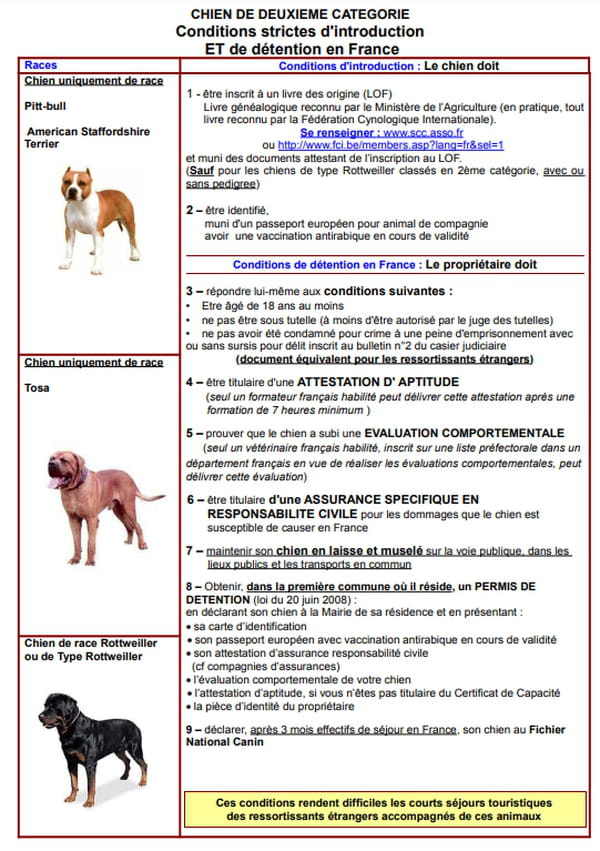Certain breeds of dogs considered dangerous appear on a list whose introduction is limited or prohibited in France, but are nevertheless present on the territory…
The legislation on the possession of dogs deemed dangerous is very strict in France. For security reasons, precise rules govern the introduction, purchase, exchange or keeping of certain breeds in the territory. The services of the Ministry of the Interior and the customs services have notably established a list of category 1 “attack dogs”belonging to a typology without pedigree, that is to say not registered in the “Book of origins”, the official register of purebred dogs.
These dogs are therefore not of recognized breed, their origin or their genealogy cannot be established with accuracy. Often resulting from crossbreeding, they include several types of canids which have in common that they are generally large, muscular and powerful. The types of dogs included in this category are:
The American Staffordshire Terrier Pitt Sweater: it is a particular type of pitt bull, a small mastiff of variable color, muscular, with a thoracic circumference of between 60 and 80 cm; weight from 18 to 40 kg; height at the withers of 35 to 50 cm. As specified by French customs, the non-bred American Staffordshire Terrier has a slightly marked stop, a muzzle the same length as the skull but less wide, strong jaws, and a massive front with a comparatively light rear.
The boerbull mastiff type: It is a generally fawn-colored mastiff, short-haired, large, muscular, with a high, massive and long body and a thoracic circumference greater than 80 cm. Its weight is more than 40 kg. The Boerbull Mastiff has a broad head with a broad skull, a rather short muzzle, and dangling lips.
The tosa type dog: This short-haired mastiff, fawn, brindle or black in color, is generally large, with a thoracic circumference greater than 80 cm. Its height at the withers of 60 to 65 cm. Its weight exceeds 40 kg. The Tosa has a broad-skulled head, a pronounced stop, a medium-length muzzle, and strong upper and lower jaws.

In addition to its introduction or importation from abroad, the legislation prohibits the purchase, sale and even donation of this type of dog in the territory. He is also banned from many public places, notably transport, is subject to a sterilization obligation and must be muzzled and kept on a leash on public roads or in the common areas of buildings. Above all, a keeping permit is required for owners who acquired this type of attack dog before the legislation was put in place. Enough, theoretically, to make it disappear.
A second, more widespread category
Other dogs, quite similar to the dogs mentioned above, but “purebred” this time, are listed in a second category. Their presence is tolerated in France, but their possession is however subject to strict conditions. The conditions for these dogs are as follows:
– Be registered in a book of origins (LOF) recognized by the Ministry of Agriculture, with documents attesting to registration in the LOF.
– Be identified and have a European pet passport.
– Have a valid rabies vaccination.
The owner must also comply with several obligations, the main ones of which are:
– Be at least 18 years old and not under guardianship, and not have been convicted of a crime and sentenced to imprisonment.
– Hold a certificate of aptitude issued after training of at least 7 hours. The dog must undergo a behavioral assessment by an authorized French veterinarian.
– Obtain a keeping permit by declaring the dog to the town hall of your residence.
– Keep your dog on a leash and muzzled on public roads, in public places and on public transport.
In addition, the dog must be declared to the National Canine File after 3 months of stay in France. What makes it difficult to keep these animals in France? The answer is more complex than it seems.
Dogs nevertheless present in France
These dogs, like the American Staffordshire Terrier, were in fact introduced into France at the end of the 1980s, 20 years before the first restrictions. The current regulations on dangerous dogs were only put in place in 2010. Enough to give them time to establish themselves and circulate in France. The “Amstaff”, whether purebred or not, has for example been the victim of a “fashion effect” in recent years, like the pit bull and the rottweiller.
Proof of this cumbersome presence: the latter, abandoned by owners who are sometimes overwhelmed, are taking up more and more space in pounds and associations, as was further recalled. South West this summer. And accidents happen very frequently. The attack on a 6-year-old girl by an American staff dog in the Oise hit the headlines at the start of the school year, another on a 10-year-old child in Antibes was reported by Var Morning very recently. In January, it was a resident of Draguignan who gave a chilling testimony to nice morning after being attacked by two rottweilers.
In 2021, a bill aimed at strengthening the legal framework put the number of dog bites (of all breeds) recorded in France by veterinary services at 250,000. Around thirty deaths from bites have been recorded over the last twenty years. An 18-month-old infant died in Yonne in July attacked by a Caucasian shepherd.
Police, gendarmerie and customs officers are regularly forced to remind citizens of the rules. If they have any doubt about the categorization of a dog, the owner of the animal must provide proof of its registration in the LOF (2nd category) or a special identification card issued by the central canine society (SCC) or the I-CAD company (1st category). In the absence of these supporting documents or in the event of inaccurate certification during an inspection, criminal sanctions, including confiscation of the dog, may be applied.

